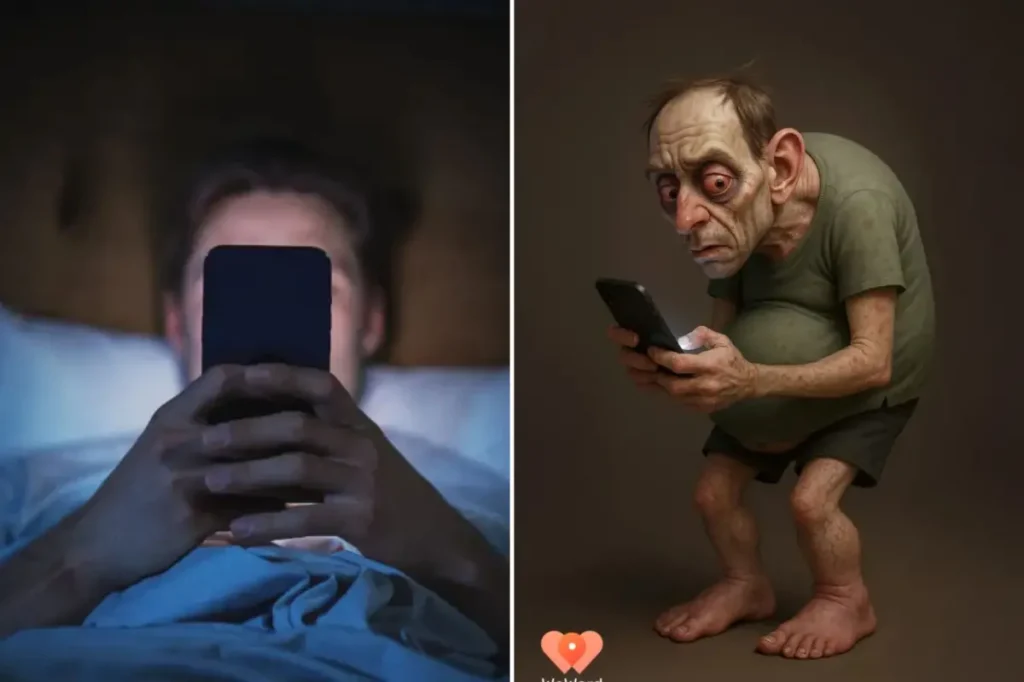The Sofa Slouch: A Glimpse into Our Sedentary Future
In an era where convenience reigns supreme, our increasingly sedentary lifestyles are silently transforming our bodies in alarming ways. Step-tracking app WeWard has unveiled a disturbing glimpse into our potential future through “Sam,” a digital creation representing what humans might look like by 2050 if current inactivity trends continue. This isn’t just Halloween-season scaremongering—it’s a medically informed projection based on data from respected health organizations like the WHO and CDC. The picture painted is grim: a future where poor posture, premature aging, and a host of health complications become the norm. As WeWard aptly puts it, “We are sofa-king screwed” if we don’t change course. With 80% of adolescents already failing to meet recommended physical activity levels, we’re witnessing the early stages of what experts call a global inactivity epidemic. The most terrifying aspect isn’t Sam’s grotesque appearance but the realization that this transformation is happening to us right now, imperceptibly, with each hour we remain glued to our screens.
The modern world has redesigned human existence around sitting. Today, virtually every aspect of life—from work meetings to socializing with friends, ordering food to entertainment—can be accomplished without ever leaving the couch. This convenience, coupled with our increasing addiction to endless social media scrolling, has created the perfect storm for physical deterioration. Sam’s body tells the story through his expanded midsection, where unused energy has converted to accumulated fat. This isn’t merely an aesthetic concern; this pattern of weight gain directly increases risk factors for life-threatening conditions including heart disease, stroke, diabetes, and various forms of cancer. Perhaps most concerning is emerging research linking sedentary behavior to cognitive decline and dementia, suggesting that our inactive lifestyles aren’t just reshaping our bodies but potentially diminishing our minds as well. The convenience we cherish today may be setting us up for decades of health complications tomorrow, with each hour of sitting adding to an invisible toll that will eventually come due.
One of Sam’s most noticeable features is his distorted posture—a forward-tilting head and curved upper back that specialists have dubbed “tech neck.” This isn’t simply a cosmetic issue; it represents structural changes occurring in the spine after prolonged periods of hunching over screens. Research published in Interdisciplinary Neurosurgery highlights how this non-neutral neck positioning creates chronic strain across the cervical spine, leading to persistent pain and discomfort that can become debilitating over time. The human body wasn’t designed for the peculiar positions demanded by our digital devices. Each time we bend our necks to check notifications or spend hours in fixed positions during video calls, we’re gradually reshaping our skeletal structure. For many of us, this transformation is already underway—manifest in stiff shoulders, neck tension, and increasingly frequent headaches. These aren’t just temporary discomforts but early warning signs of the more permanent postural changes illustrated by Sam’s hunched figure.
Our screens aren’t just changing our posture—they’re aging us prematurely. Sam’s haggard appearance reflects the compounding effects of blue light exposure, which multiple studies have linked to hyperpigmentation and accelerated skin aging. The irony isn’t lost that many spend hours scrolling through anti-aging product advertisements while the very act of scrolling contributes to their aging process. Beyond skin damage, our constant screen fixation is wreaking havoc on our eyes. The unnatural demand to focus at one distance for extended periods reduces our blink rate and creates a cascade of visual problems: chronic dryness, blurred vision, headaches, and difficulty focusing. Health experts recommend the 20-20-20 rule—looking at something 20 feet away for 20 seconds every 20 minutes of screen time—but in practice, few of us maintain such discipline. As our work and social lives become increasingly screen-dependent, these vision problems are becoming normalized rather than addressed, setting the stage for the strained, tired eyes that characterize Sam’s appearance.
The consequences of sedentary living extend to our extremities as well. Sam’s swollen ankles and feet illustrate how prolonged sitting disrupts normal circulation, allowing fluids to accumulate in the lower limbs. This isn’t just uncomfortable—it can lead to more serious complications including varicose veins and potentially life-threatening blood clots. The gravity of this risk was tragically highlighted in 2020 when a 24-year-old man died from a blood clot after marathon gaming sessions during pandemic lockdown. Beyond circulation issues, extended inactivity contributes to joint stiffness and accelerates the onset of arthritis as our bodies lose the regular movement needed to maintain healthy joint function. Even our hair and skin suffer, with reduced circulation contributing to thinning hair and dull complexion. The puffy bags under Sam’s eyes aren’t just from late-night scrolling—they represent the systemic inflammation and fluid retention that comes from hours of physical inactivity.
The future Sam represents isn’t inevitable—it’s a warning. WeWard’s project aims to shock us into awareness by personalizing the consequences of inactivity. They’ve even created a tool allowing users to upload their own photos to see personalized projections of how continued sedentary habits might transform their appearance by 2050. This stark visualization technique leverages our natural vanity to motivate behavioral change where health statistics alone might fail. The solution isn’t complicated, though it does require conscious effort: build movement back into daily life. This doesn’t necessarily mean intensive gym sessions, but rather breaking up prolonged sitting with short movement breaks, taking walking meetings instead of video calls, or standing while watching television. The human body evolved for movement, and even modest increases in physical activity can substantially mitigate the effects displayed in Sam’s disturbing portrait. Our technological progress needn’t come at the expense of our physical well-being—but achieving balance requires acknowledging the very real physical toll our convenience-oriented lifestyle is taking. The sofa goblin future isn’t inevitable, but avoiding it will require us to get up and move.















